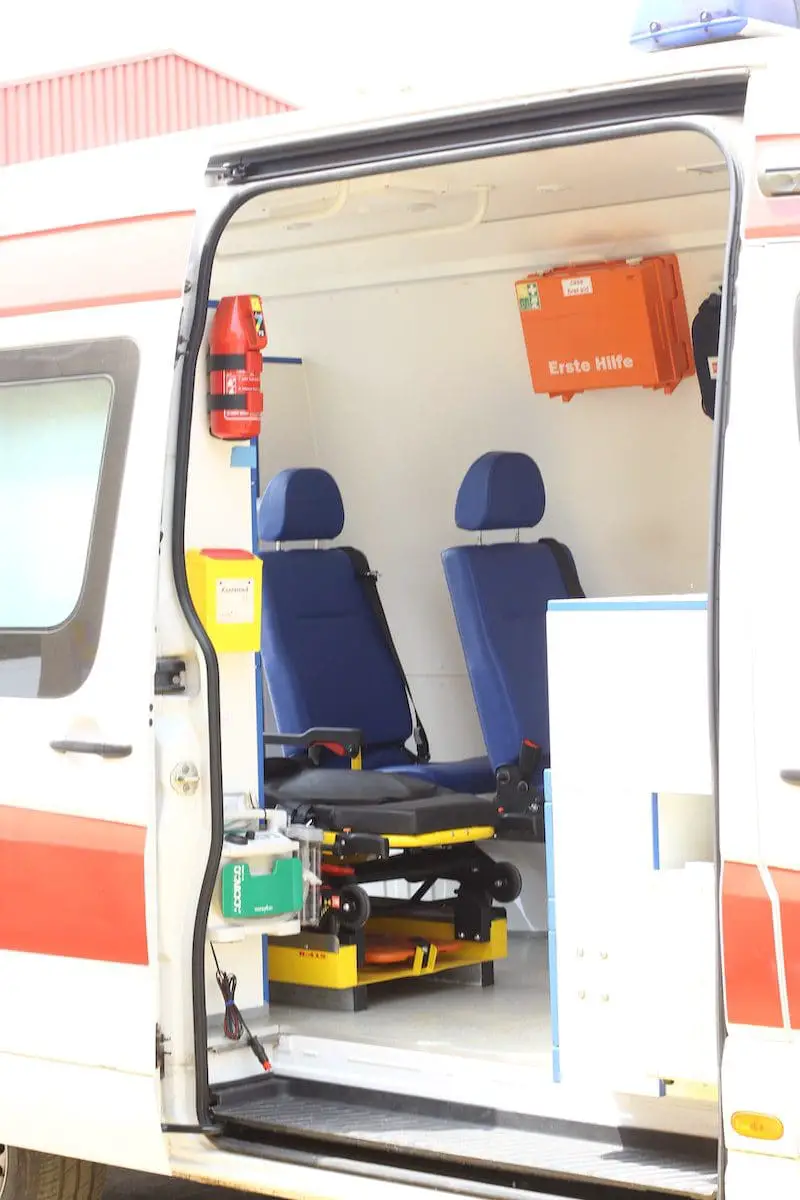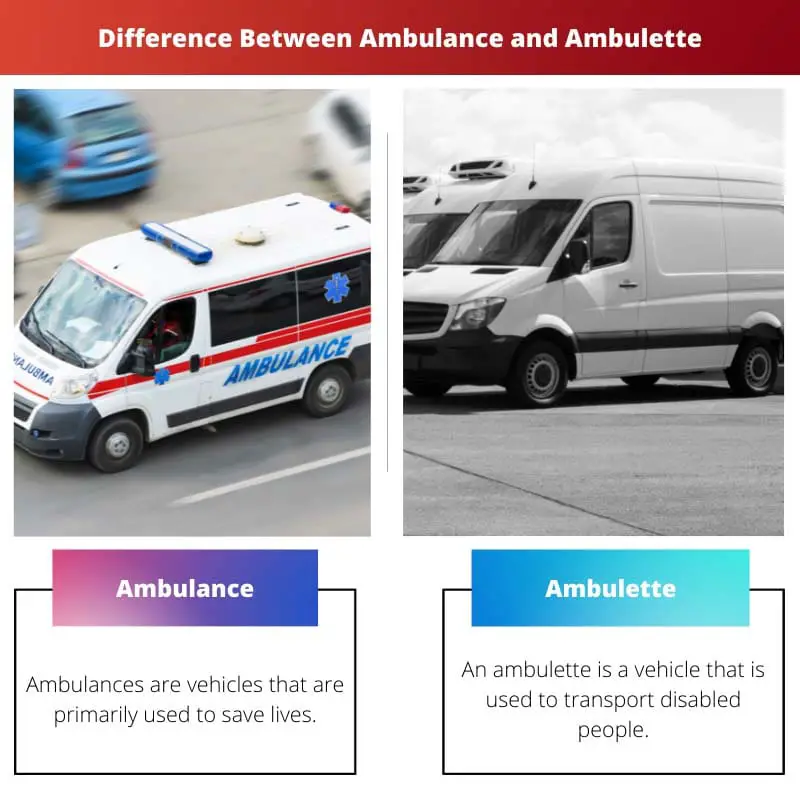When you have serious injuries or become ill, you need to get to the hospital as soon as possible to receive medical treatment. In this circumstance, you’ll most likely dial 108, wait for paramedics to come, and be taken to a hospital in their ambulance.
Will you be brought to an ambulette or an ambulance? It is the inquiry of the day. Also, does it make a significant difference?
Ambulance and ambulette are related but distinct terms. These two terms refer to the vehicle which is used to transfer sick patients. Let’s compare the differences between the two and contrast.
Key Takeaways
- An ambulance is a vehicle designed to transport patients who require medical attention. At the same time, an ambulette with a table is a modified van that allows for transporting non-emergency patients who require a stretcher or wheelchair.
- Ambulances are equipped with medical equipment and trained medical personnel, while ambulettes may have basic medical equipment but are staffed with a driver and attendant.
- Ambulances are used in emergencies, while ambulettes are used for routine medical appointments and non-emergency transport.
Ambulance vs Ambulette
An ambulance is a vehicle designed to transport patients who require urgent medical attention and can provide medical care during transportation. An ambulette is a non-emergency vehicle used to transport patients who are stable but require help getting to and from medical appointments.

An ambulance is a vehicle intended particularly to transport people who require medical assistance.
Many people are aware of the idea of an urgent ambulance, which is a vehicle that transports patients to critical treatment in an emergency department as quickly as possible.
Ambulances are granted primacy on the road in almost all countries, acknowledging that speed is essential when transporting critically ill or badly injured patients.
An ambulette is a vehicle that is slightly larger than an ambulance. In addition, an ambulette may transport more people than an ambulance.
In non-emergency settings, a van or similar vehicle is fitted to carry people with limited mobility (such as wheelchair-bound patients).
Comparison Table
| Parameters of Comparison | Ambulance | Ambulette |
|---|---|---|
| Definition | Ambulances are vehicles that are primarily used to save lives. | An ambulette is a vehicle that is used to transport disabled people. |
| Use | Life-threatening circumstances are handled by ambulances. | Ambulettes are used to help people with impairments and are not intended to be used in an emergency. |
| Vehicle includes | Ambulances have flashing lights, sirens, and alarms. | There may just be flashlights on an ambulette; there are no sirens. |
| Equipped with | A life-supporting system is installed in an ambulance. | An ambulette is seen with wheelchair ramps and hydraulic elevators. |
| Para- Medical Staff | Available | Not- Available |
| Size | Smaller in size. | Comparatively larger. |
What is Ambulance?
An Ambulance is a medically furnished vehicle that delivers patients to medical treatment facilities such as hospitals is known. The patient is given medical care outside of the hospital in the ambulance.
Emergency medical services use ambulances to quickly assist with medical crises. They are provided with flashing warning lights and sirens for this reason.
They may immediately convey paramedics and other first rescuers to the incident, carry emergency medical items and carry patients to hospitals or other long-term care facilities.
The majority of ambulances are built on vans or commercial vehicles.
Ambulance layout must depend on specific infrastructure and circumstances.
Although adequate roadways are required for road-going ambulances to reach the incident and take the victim to treatment, four-wheel drive or whole vehicles can be employed in rough places.
Fuel has to be readily available, and service facilities are required to keep the vehicle in good working order.
The word ambulance comes from the Latin word “ambulare”, which means “ to move ” around or stroll. An ambulance was originally defined as a “moving hospital” that trailed an army.
Patients were transported in carts in ancient times. An ambulance is a vehicle used for emergency lifesaving transportation during a medical emergency, according to most definitions.

What is Ambulette?
A vehicle used to carry someone for medical treatment but not in a life-threatening condition is known as an ambulette.
Ambulances are ambulettes for the most part, as they may carry patients in non-emergencies without the need for sirens.
Some ambulettes have been replaced to make them available for wheelchairs, for example, by installing a staircase, rail, or a lift.
The type of ambulette vehicle chosen is based on what is practicable and required in the area. The ambulette is a simple transport vehicle with enough space in the back for wheelchairs to be secured with appropriate belts.
Mechanical lifts are used to transport patients into the vehicle. Ambulettes, on the other hand, are not designed to handle emergency circumstances because they lack lifesaving gear.
What your ambulette service may provide is determined by your region and company characteristics. Ambulette services are available in several places, and they frequently carry wheelchair-bound individuals to and from appointments.
Other localities provide ambulette services for disabled patients’ fundamental requirements, such as appointments, weekly grocery assistance, trips to the bank or post office, etc.
The assistance also involves removing obstructions that may impede the patient’s safe movement, as well as walking the stairs.
Ambulette service is ideal for impaired individuals who do not want to be subjected to intensive medical care while in transit.
Furthermore, it is required for transferring disabled or impaired individuals who are not at an urgent risk of harming their health.

Main Differences Between Ambulance and Ambulette
- Ambulances are vehicles used primarily to save lives, whereas an Ambulette is a vehicle used to carry disabled individuals.
- Ambulances tackle life-threatening situations, whereas ambulette is not designed to be utilized in emergencies.
- Ambulances have lighting, sirens, and alarms, whereas ambulettes may only have torches and no sirens.
- An ambulance is outfitted with a life-supporting system, whereas an ambulette is outfitted with wheelchair ramps and mechanical lifts.
- The ambulance has Para-Medical professionals, whereas Ambulette has none.

- https://elibrary.ru/item.asp?id=2817993
- https://scholarlyworks.lvhn.org/cgi/viewcontent.cgi?article=1577&context=research-scholars-posters

Very informative post! The differences between ambulances and ambulettes are now very clear to me. Thank you for this detailed explanation.
I agree, Emiller. This article provides a comprehensive breakdown of the distinctions between the two types of vehicles. It’s an essential read for anyone interested in emergency medical transportation.
Kudos to the author for the clear and concise information. It’s refreshing to find such well-structured content on a complex topic.
I couldn’t agree more, Mdavies. This article is a testament to how clarity and organization can enhance the understanding of intricate subjects.
The post meticulously navigates through the nuances of ambulance and ambulette transportation. It’s a commendable effort to demystify the intricacies of these medical vehicles.
I echo your sentiments, Erin06. The detailed exploration of both vehicles is a testament to the dedication of the author in elucidating complex medical concepts.
The article effectively highlights the necessity of differentiating between ambulances and ambulettes. This type of distinction can have a significant impact on providing the appropriate medical care.
I share your perspective, Caroline88. The article underscores the importance of understanding the right type of transportation for different medical needs effectively.
I never realized there were such clear distinctions between ambulances and ambulettes. Thank you for the enlightening information.
Although the article explains the differences well, the tone seems a bit too formal and monotonous. A more engaging writing style could make it more captivating and approachable.
I understand your point, Donna. It would be beneficial to make such important information more engaging to a wider audience.
I actually appreciate the formality of the writing. It gives the impression of authority and credibility, which is crucial in a medical context.
The comparison table at the end of the article is particularly helpful. It succinctly outlines the disparities between ambulances and ambulettes for easy reference.
I couldn’t agree more, Ken Cox. The comparative table encapsulates key details in a digestible format for quick consultation.
The direct comparison between the two vehicles helps to clarify their purposes. This is a very useful resource for anyone seeking to understand emergency medical transportation options.
I completely agree, Tbell. The side-by-side analysis of ambulances and ambulettes is valuable for anyone trying to comprehend their differences.